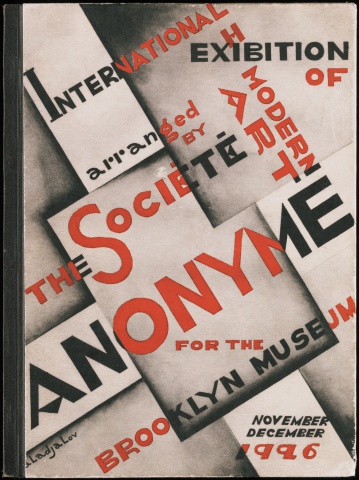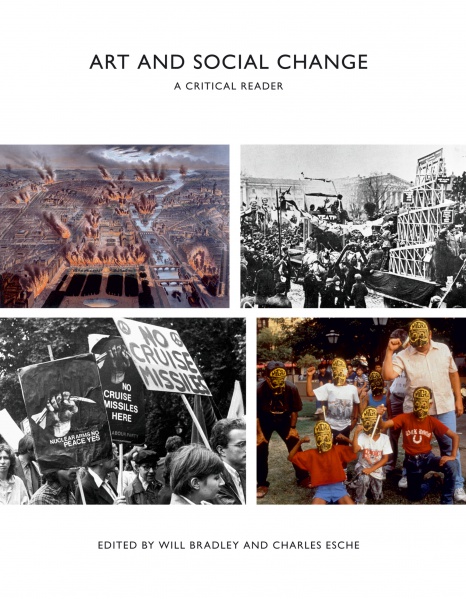Société Anonyme: International Exhibition of Modern Art, catalogue (1926)
Filed under catalogue | Tags: · art, avant-garde

Cover via Beinecke Rare Book and Manuscript Library
The title for this major exhibition prepared by the Société Anonyme (Katherine S. Dreier, Marcel Duchamp, Man Ray) for the Brooklyn Museum “was lifted from the 1913 Armory Show, in which Dreier was represented by two paintings, and in its scope it rivalled the 1917 Society of Independent Artists exhibition. Dreier had four galleries in the exhibition made up to resemble rooms in a house to illustrate how modern art could and should readily integrate into an everyday domestic environment, and there was also a prototype of a ‘television room’, designed in conjunction with Frederick Kiesler, which would make any house or museum a worldwide museum of art by illuminating different slides of masterpieces with the ‘turn of a knob’. Concurrent with the exhibition the Société sponsored eighteen lectures, fourteen of which were delivered by Dreier herself. Opened on 18 November, the Brooklyn exhibition featured 308 works by 106 artists from 23 countries and attracted over 52,000 visitors in seven weeks.” (from John D. Angeline, “Stuart Davis and El Lissitzky”, 1997)
With a text by Katherine S. Dreier
Composed by Katherine S. Dreier and Constantin Aladjalov,
Société Anonyme, New York, and Museum of Modern Art, New York
124 pages
via Archive.org
Exhibition review (New York Herald Tribune, December 1926)
Review of the Buffalo installment of the exhibition (The Evening Telegram Toronto, March 1927)
Review of the Toronto installment of the exhibition (Toronto Daily Star, March 1927)
Commentary (William Clark, Variant, 2001)
PDF (PDF assembled from the Archive.org’s JP2 scans, 53 MB, no OCR)
View online (Archive.org)
Ken Knabb (ed.): Situationist International Anthology (1981/2006)
Filed under book | Tags: · art, avant-garde, capitalism, consumerism, everyday, life, mass media, politics, psychogeography, situationists, spectacle, theory

“In 1957 a few experimental European groups stemming from the radical tradition of dadaism and surrealism, but seeking to avoid the cooption to which those movements succumbed, came together to form the Situationist International. The name came from their aim of liberating everyday life through the creation of open-ended, participatory “situations” (as opposed to fixed works of art) — an aim which naturally ran up against the whole range of material and mental obstacles produced by the present social order. Over the next decade the situationists developed an increasingly incisive critique of the global ‘spectacle-commodity system’ and of its bureaucratic leftist pseudo-opposition, and their new methods of agitation helped trigger the May 1968 revolt in France. Since then — although the SI itself was dissolved in 1972 — situationist theories and tactics have continued to inspire radical currents in dozens of countries all over the world.
The SI Anthology, generally recognized as the most comprehensive and accurately translated collection of situationist writings in English, presents a chronological survey of the group’s activities and development as reflected in articles from its French journal and in a variety of leaflets, pamphlets, filmscripts and internal documents, ranging from their early experiments in urban “psychogeography” and cultural subversion to their lucid analyses of the Watts riot, the Vietnam war, the Prague Spring, the Chinese “Cultural Revolution” and other crises and upheavals of the sixties.
A greatly revised, and expanded edition, with over 100 pages of new material.”
First published in 1981
Translated by Ken Knabb
Publisher Bureau of Public Secrets, Berkeley, CA, 2006
No copyright. Any of the texts in this book may be freely reproduced, translated or adapted, even without mentioning the source.
ISBN 0939682044, 9780939682041
532 pages
via quackalist
Reviews: Libero Andreotti (J Architectural Education, 1996), Not Bored! (2007).
HTML (from the publisher)
PDF (7 MB, added on 2019-11-13)
EPUB (updated on 2019-11-13)
Will Bradley, Charles Esche (eds.): Art and Social Change: A Critical Reader (2007)
Filed under book | Tags: · aesthetics, art, art history, art theory, avant-garde, bauhaus, constructivism, dada, politics, revolution, situationists, social movements, subversion, zapatistas

“The desire to change the world has often led artists to align themselves with wider social movements and to break with established institutions of art. This reader gathers together an international selection of artists’ proposals, manifestos, theoretical texts and public declarations that focus on the question of political engagement and the possibility of social change. The approaches represented are many and diverse, from Gustave Courbet’s involvement in the Paris Commune and the socialist art theory of William Morris to the hybrid activist practice associated with the twenty-first century ‘movement of movements’; from the political commitments of the Modernist avant-gardes to the rejections of Modernism in favour of protest, critique, utopian social experiment or revolutionary propaganda. Six specially commissioned essays – by Geeta Kapur, Lucy Lippard, John Milner, Gerald Raunig, Marina Vishmidt and Tirdad Zolghadr – further explore both the historical context and the contemporary situation.”
Publisher Tate Publishing, in association with Afterall, London, 2007
ISBN 9781854376268
479 pages
Commentary: Marco Deseriis and Brian Holmes (Mute).
Comments (3)
